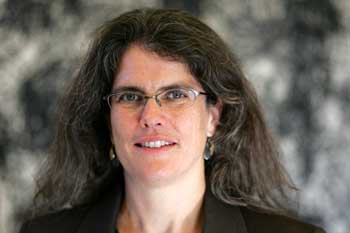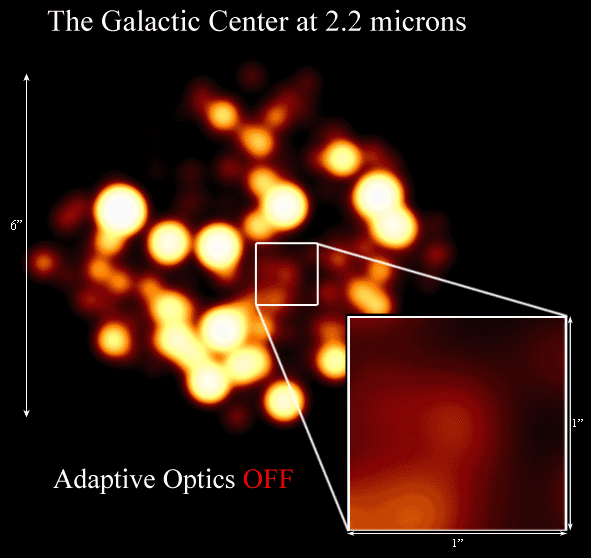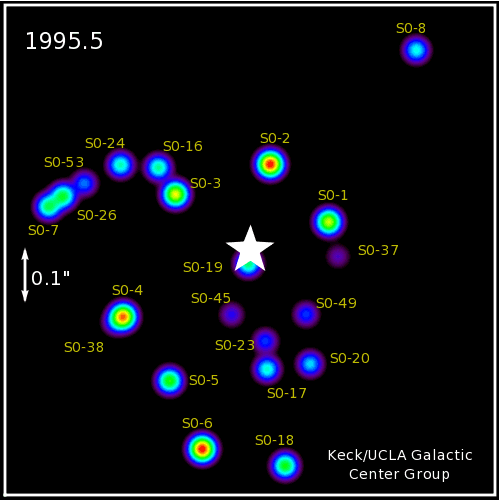Andrea Ghez

Image courtesy of Andrea Ghez.
There's a great celestial chasm lurking at the heart of our galaxy, capable of swallowing anything that gets too close. It hides in plain sight, and its pull is strong enough to whip stars around like they were toys. Now a team at the University of California Los Angeles is methodologically peeling away its secrets. Meet Andrea Ghez, black hole hunter extraordinaire.
It is impossible to see a black hole directly. Black holes are objects out in the cosmos with pulls of gravity so strong, not even light can escape, rendering it completely dark. Its gravitational pull is so strong, an object would have to be travelling impossibly faster than the speed of light to escape its clutches.
However if the black hole is near a bright object like a star, observing the star's motions are the key to unlocking the secrets of the black hole.
That's what Ghez did. She trained the powerful Keck telescopes in Hawaii toward the center of the galaxy to see what she might be able to learn about the black hole thought to reside there by watching the motions of the nearby stars. However even seeing the stars at the center of the galaxy is no easy feat.
"The Earth's atmosphere distorts our view of astronomical sources," Ghez said. "It's very much like looking at a pebble at the bottom of a moving river; you have a very distorted view. So if you want to have a good view, you need to figure out a way to make that river stay put, and that's what we're doing with adaptive optics."
Essentially, adaptive optics takes the twinkle out of starlight. The stars in the sky seem to flicker because our planet's air pressure and temperature are constantly changing, distorting the starlight.

Animation showing how much laser guide star adaptive optics can clear up an image of the center of the galaxy. Images/animations created by Prof. Andrea Ghez and her research team at UCLA and are from data sets obtained with the W. M. Keck Telescopes.
To overcome this, Ghez and her team shone powerful lasers into the atmosphere next to the star they wanted to study. The laser creates a spot in the sky, what astronomers call an artificial star. A computer tracks the movements of this artificial star, and corrects for atmospheric distortions by subtly shifting the surface of the telescope's mirror thousands of times a second.
"It's sort of like the atmosphere introducing a circus funhouse mirror that changes every few tenths of a second, and introducing a conjugate funhouse mirror that is also changing very quickly," Ghez said.
After the lasers cleared up the view to the center of the galaxy, Ghez and her team started taking data. The center of the galaxy is very different place than farther out, where our solar system resides. Here, about 25,000 light-years from the center, the next nearest star is four light-years away. In the center of the galaxy, dozens of stars can be found moving quickly about in the same area. One star in particular was traveling around in an orbit the size of our solar system once every 15 years. It takes Neptune, the planet farthest out from the Sun, almost 165 years to make the same sized trip.
What that fast-moving star was orbiting around was what Ghez was after. Ghez tracked the stars for 16 years, plotting their orbits, figuring out their size and speed. They all orbited around a single point, but nothing showed up on the telescope. It had to be the black hole Ghez and her team was after.
To get stars moving these colossal speeds, the black hole would have to be huge. Ghez calculated that the gravitational force needed to sling stars around like that, would have to be about four million times the mass of the Sun, in other words it would be a very massive black hole. The team was the first to be able to confirm that the black hole was there; the question now, was where it came from.

Animation showing the orbits of stars around the black hole at the center of our galaxy (marked with a star). Images/animations created by Prof. Andrea Ghez and her research team at UCLA and are from data sets obtained with the W. M. Keck Telescopes.
Conventional black holes form when a star about three times the size of our own reaches the end of its life. It erupts in a cataclysmic explosion, a supernova, compressing its core to an infinitesimally small point. The black holes at the center of most galaxies are however no ordinary black holes.
"These big black holes, the million to a billion times the mass of our sun black holes that are found at the center of our galaxy, were not predicted by theory. They were found observationally and now our job is to understand how these things formed," Ghez said.
Other mysteries started popping up too. Stars are formed when gas and dust floating in space coalesce together and thermonuclear fusion takes place. A black hole should be a terrible place for baby stars to form, because it is always pulling matter away from these points where matter collects. When Ghez and her team looked at the kinds of stars orbiting around the black hole, that's not at all what they saw.
"The prediction is no young stars, lots of old stars. And yet what we see is lots of young stars and very few old stars, it's the exact opposite. And that's the fun of research," Ghez said.
Because of her research, she's appeared on TV shows on the BBC, the Learning Channel, the History Channel and PBS. In July of 2009, Ghez presented her research at the annual TED conference in Oxford England.
"It was a talk unlike any other I've ever given," Ghez said "I was given two pieces of instructions, one was I could only speak for eighteen minutes exactly. And two, I should use no words on my viewgraph. Which is very different than the typical talk, even a public talk that one might give, because we're used to the crutch of having words on our slides. But it was fun, and it was a great experience to meet people from all different disciplines."
Ghez remembers that one of her big influences when she was young was when Neil Armstrong became the first person to walk on the Moon. She wanted to grow up to be a ballet dancer at the time, but the excitement of the first moonwalk stuck with her. In school she always liked science and math classes and solving puzzles in her spare time. She went on to receive her bachelor's in physics at MIT and PhD at Caltech.
"Today I think of science and research as just one big puzzle. It's a lot of fun, you have to work out what the right answer is," Ghez said. "I was always drawn to astrophysics because you could ask the big questions; ‘How did it all begin?' Those were the things that used to keep me up at night."
When not peering deep into the cosmos or telling the world about her research, she's likely spending time with her husband Tom and two sons Evan and Miles, swimming, or relaxing with a good novel.











